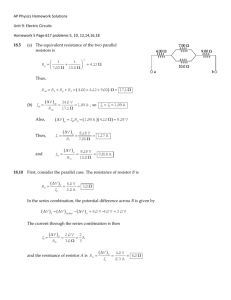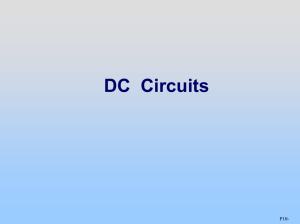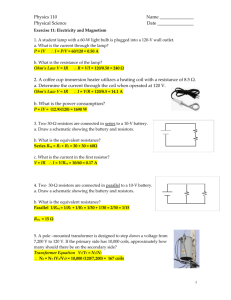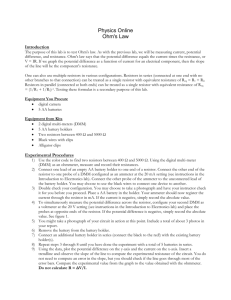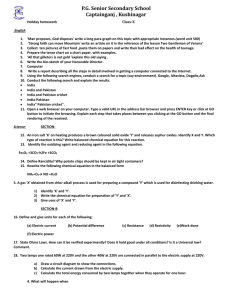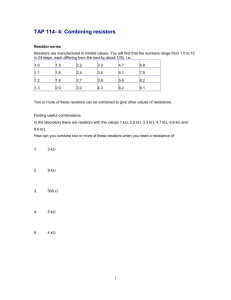Problem Set 06
advertisement
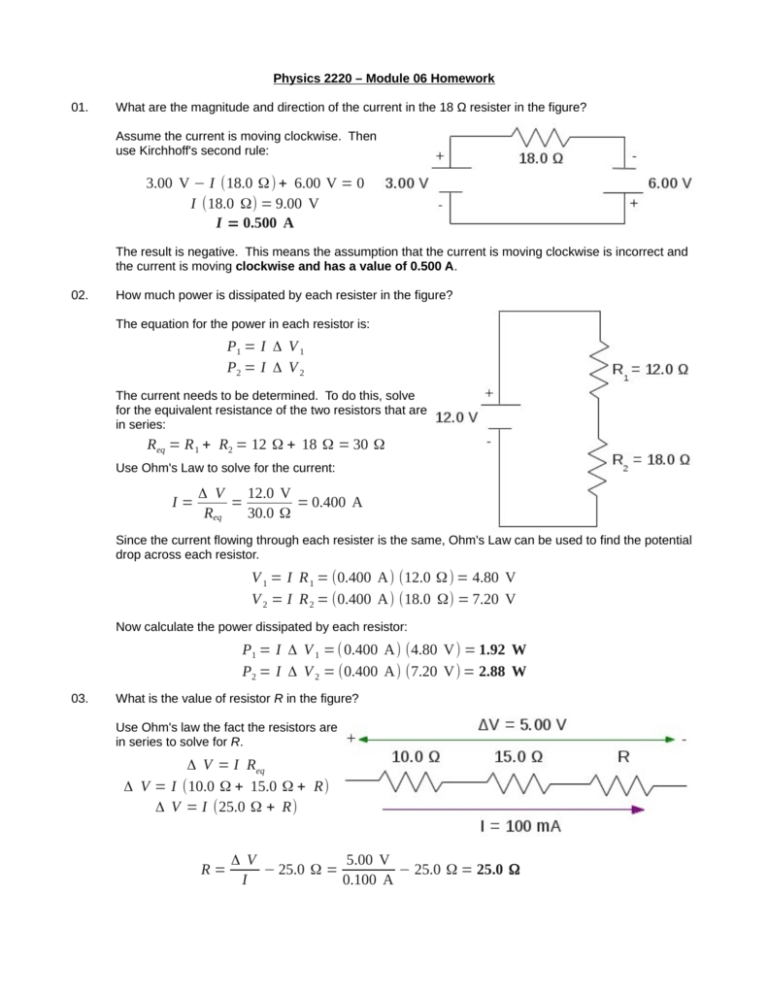
Physics 2220 – Module 06 Homework 01. What are the magnitude and direction of the current in the 18 Ω resister in the figure? Assume the current is moving clockwise. Then use Kirchhoff's second rule: 3.00 V − I (18.0 Ω) + 6.00 V = 0 I (18.0 Ω) = 9.00 V I = 0.500 A The result is negative. This means the assumption that the current is moving clockwise is incorrect and the current is moving clockwise and has a value of 0.500 A. 02. How much power is dissipated by each resister in the figure? The equation for the power in each resistor is: P1 = I Δ V 1 P2 = I Δ V 2 The current needs to be determined. To do this, solve for the equivalent resistance of the two resistors that are in series: Req = R 1 + R2 = 12 Ω + 18 Ω = 30 Ω Use Ohm's Law to solve for the current: I= Δ V 12.0 V = = 0.400 A Req 30.0 Ω Since the current flowing through each resister is the same, Ohm's Law can be used to find the potential drop across each resistor. V 1 = I R 1 = (0.400 A) (12.0 Ω) = 4.80 V V 2 = I R 2 = (0.400 A) (18.0 Ω) = 7.20 V Now calculate the power dissipated by each resistor: P1 = I Δ V 1 = (0.400 A) (4.80 V) = 1.92 W P2 = I Δ V 2 = (0.400 A) (7.20 V) = 2.88 W 03. What is the value of resistor R in the figure? Use Ohm's law the fact the resistors are in series to solve for R. Δ V = I Req Δ V = I (10.0 Ω + 15.0 Ω + R) Δ V = I (25.0 Ω + R) R= Δ V 5.00 V − 25.0 Ω = − 25.0 Ω = 25.0 Ω I 0.100 A 04. The battery in the figure is short-circuited by an ideal ammeter having zero resistance. (a) What is the battery's internal resistance? Use Ohm's Law to find the internal resistance: 1.50 V r=ε= = 0.652 Ω I 2.30 A (b) How much power is dissipated inside the battery? Pr = I 2 r = (2.30 A)2 (0.6522 Ω) = 3.45 W 05. The voltage across the terminals of a 9.0 V battery is 8.5 V when the battery is connected to a 20 Ω load. What is the battery's internal resistance? The 0.5 V drop in voltage from the battery to the terminals is due to the internal resistance. Use Ohm's Law and the fact the internal resistance and load resistor are in series to determine the current through the circuit. ε = Ir + IR ε − (Ir ) 9.0 V − 0.5 V I= = = 0.425 A R 20 Ω Now use the current to find the internal resistance: r= 06. Δ Vr 0.5 V = = 1.2 Ω I 0.425 A What is the equivalent resistance between points a and b in the figure? Label the resistors as follows: R1 = 10.0 Ω R2 = 40.0 Ω R3 = 55.0 Ω R4 = 20.0 Ω R5 = 10.0 Ω (bottom) Resistors R1 and R2 are in series with each other: R6 = R1 + R 2 = 10.0 Ω + 40.0 Ω = 50.0 Ω Resistors R3 and R4 are in series with each other: R7 = R3 + R 4 = 55.0 Ω + 20.0 Ω = 75.0 Ω The new resistors R6 and R7 will now be in parallel with each other: 1 1 1 1 1 = + = + R 8 R6 R 7 50.0 Ω 75.0 Ω R 8 = 30.0 Ω Finally, the new resistor R8 will be in series with R5, which will combine to be the equivalent resistance. Req = R 8 + R5 = 30.0 Ω + 10.0 Ω = 40.0 Ω 07. What is the equivalent resistance between points a and b in the figure? Label the resistors as follows: R 1 = 42 Ω R 2 = 60 Ω (left) R3 = 60 Ω (middle) R 4 = 45 Ω R 5 = 40 Ω Resistors R2, R3, and R4 are in parallel with each other: 1 1 1 1 1 1 1 = + + = + + R 6 R2 R 3 R4 60 Ω 60 Ω 45 Ω R6 = 18 Ω The new resistor R6 and R1 will now be in series with each other: R7 = R6 + R 1 = 18 Ω + 42 Ω = 60 Ω Finally, the new resistor R7 will be in parallel with R5, which will combine to be the equivalent resistance. 1 1 1 1 1 = + = + R eq R 7 R5 60 Ω 40 Ω R eq = 24 Ω 08. What is the time constant for the discharge of the capacitors in the figure? Each of the capacitors in series and resistors in series need to first be combined. Req = 1 k Ω + 1 k Ω = 2 k Ω 1 1 1 = + C eq 2 μ F 2 μ F C eq = 1 μ F Now determine the time constant: τ = R eq C eq = (2 k Ω) (1 μ F) = 0.002 s = 2 ms 09. What value resistor will discharge a 1.0 μF capacitor to 10% of its initial charge in 2.0 ms? To represent the capacitor to be 10% of its initial charge: The equation to discharge a capacitor is: Q = 0.10 Q 0 − Q = Q0 e t RC Solve for the resistor: t − Q = e RC Q0 ln ( QQ ) = − RCt 0 R=− t C −3 1 2.0 × 10 s 1 =− = 8.69 × 102 Ω = 0.87 k Ω −6 ln ( 0.10) Q 1.0 × 10 C ln Q0 ( ) 10. What is the equivalent resistance between points a and b in the figure? Label the resistors as follows: R1 = 2 Ω R2 = 6 Ω R3 = 12 Ω R4 = 4 Ω R5 = 10 Ω R6 = 3 Ω Resistors R2, R3, and R4 are in parallel with each other: 1 1 1 1 1 1 1 = + + = + + R7 R 2 R3 R4 6 Ω 12 Ω 4 Ω R7 = 2 Ω Notice now current can either go through the 10 Ω resistor, or go through a wire with no resistance. The current will go through the path of zero resistance, so the 10 Ω resistor can be ignored. This puts the remaining resistors all in series. Req = R 1 + R 7 + R6 = 2 Ω + 2 Ω + 3 Ω = 7 Ω 11. For the given circuit: (a) (b) What is the magnitude of current through each section of the circuit? Calculate the power dissipated in each resistor in the circuit. Redraw the circuit. Include guesses for directions of current and direction or labels for current loops: Apply Kirchoff's first rule at junction e (equation 1): I1 + I2 = I3 Apply Kirchoff's second rule for current loop abefa (equation 2): −(6 Ω) I 3 + 12 V − (2 Ω) I 1 − 14 V = 0 −(6 Ω) I 3 − (2 Ω) I 1 − 2 V = 0 Apply Kirchoff's second rule for current loop bcdeb (equation 3): −(5 Ω) I 2 + (2 Ω) I 1 − 12 V = 0 Combine equation 1 with equation 2: −(6 Ω) (I 1 + I 2 ) − (2 Ω) I 1 − 2 V = 0 −(6 Ω) I 1 − (6 Ω) I 2 − (2 Ω) I 1 − 2 V = 0 −(8 Ω) I 1 − (6 Ω) I 2 − 2 V = 0 Multiply equation 4 by 4: −(20 Ω) I 2 + (8 Ω) I 1 − 48 V = 0 Add the equations in bold: −(26 Ω) I 2 − 50 V = 0 −(23 Ω) I 2 = 50 V I 2 = −2.17 A Remember if the current is negative, then the true direction of the current is opposite the guessed. Use equation 2 to solve for I1: −(5 Ω) I 2 + (2 Ω) I 1 − 12 V = 0 12 V + (5 Ω) I 2 I1 = (2 Ω) 12 V + (5 Ω) (−2.17 A) I1 = (2 Ω) I 1 = 0.57 A Use equation 1 to determine I3: I1 + I2 = I3 I 3 = (0.57 A) + (−2.17 A) I 3 = −1.60 A Finally, solve for the power dissipated across each resister. P2 = I 21 (2.0 Ω) = (0.57 A)2 (2.0 Ω) = 0.65 W P5 = I 22 (5.0 Ω) = (2.17 A)2 (5.0 Ω) = 23.5 W P6 = I 23 (6.0 Ω) = (1.60 A)2 (6.0 Ω) = 15.4 W
